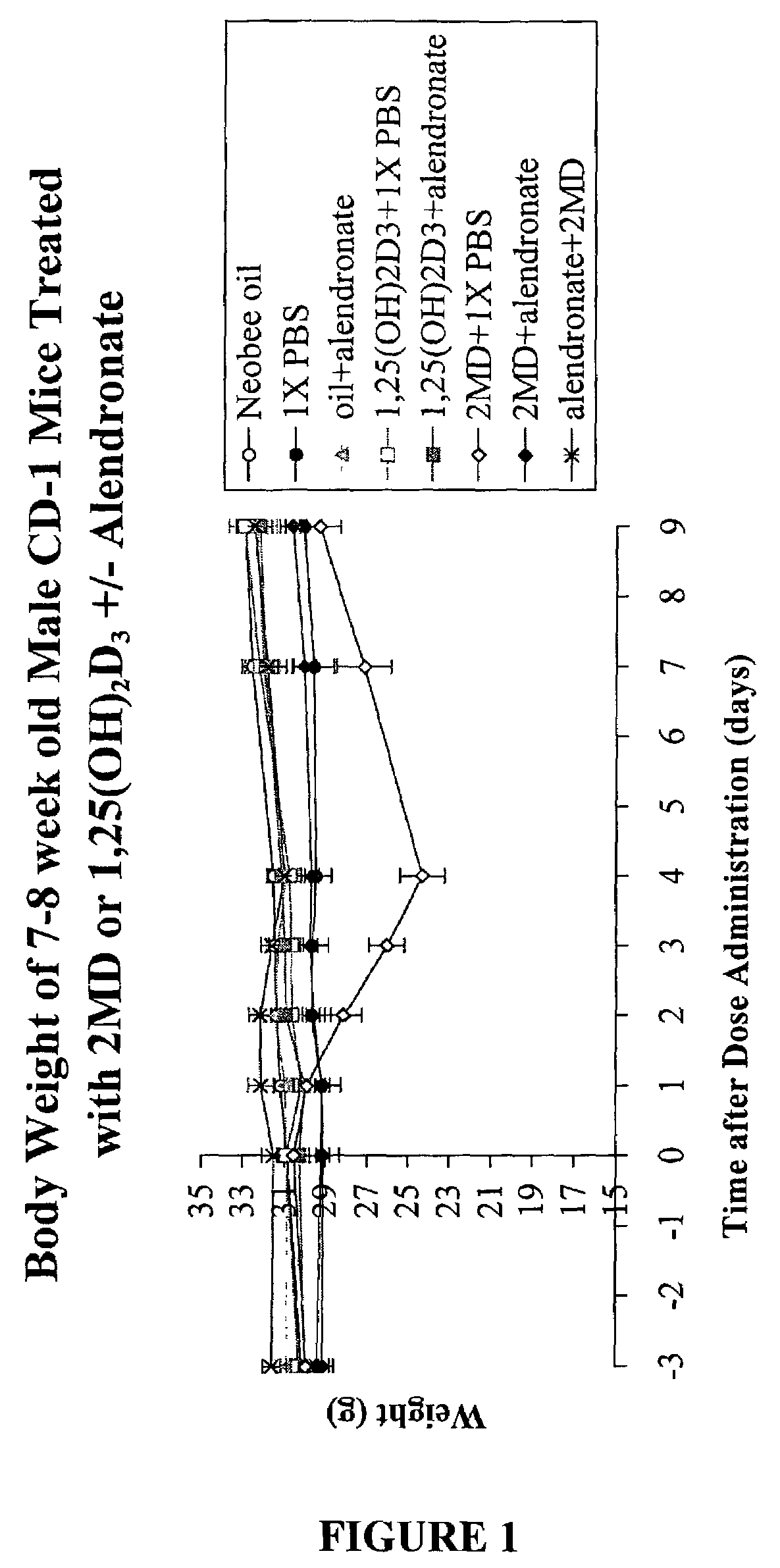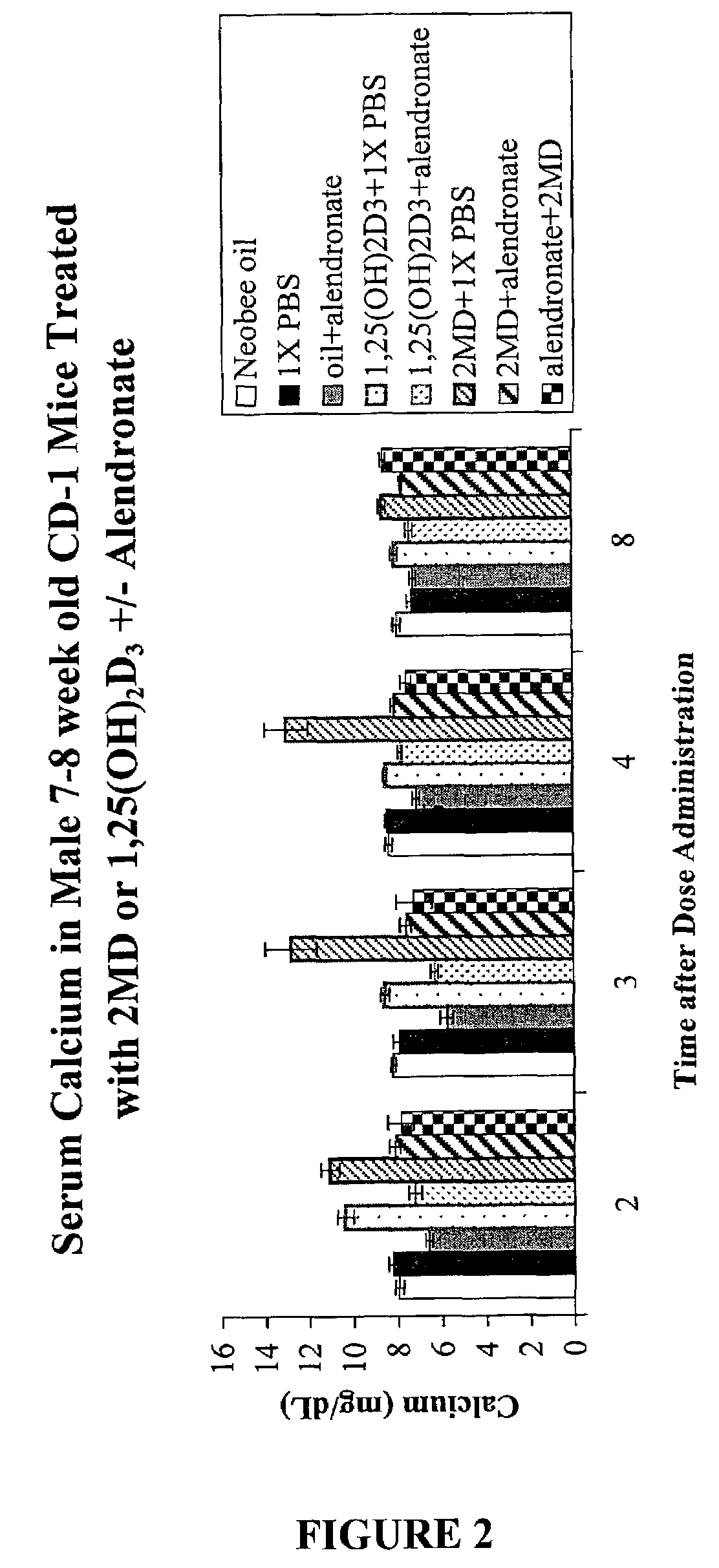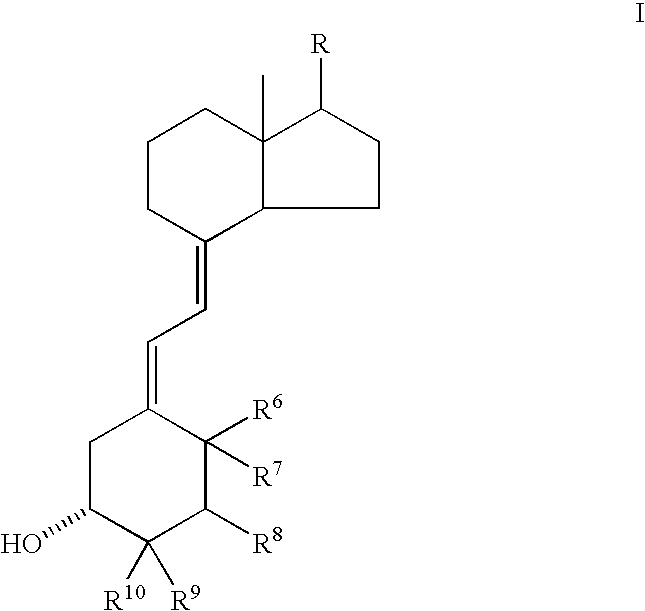[0002]It is also known that 1,25-(OH)2D3 functions through a
receptor that dimerizes with the
protein, RXR (
retinoid X receptor), on responsive elements of target genes to either stimulate or suppresses transcription. The
gene products then carry out the functions attributed to 1,25-(OH)2D3. With the development of receptor knockout mice, and the discovery that Type II vitamin D-dependent
rickets is the result of a
mutation or mutations in the vitamin D receptor (VDR), it is very clear that most, if not all, actions of vitamin D are mediated through the VDR. This receptor has been found in tissues not previously considered targets of vitamin D action and certainly not considered as playing a role in its functions to mobilize calcium and phosphorus. Such targets are the
parathyroid gland, the keratinocytes of
skin, the
islet cells of the
pancreas, and the lymphocytes. Further, Suda and his colleagues (Abe et al, “Differentiation of Mouse Mycloid
Leukemia Cells Induced by 1α,25-dihydroxyvitamin D3”, Proc. Natl. Acad. Sci., Vol. 78, No. 8, pp. 4990-4994, 1981) have clearly shown that the vitamin D
hormone, i.e. 1,25-(OH)2D3, causes the differentiation of promyelocytes to monocytes, an action not considered to be related to calcium. Because of this differentiation and suppression of growth of
cancer tissues in culture, the possibility that vitamin D compounds might be used in a differentiative treatment of cancer has emerged in an enthusiastic fashion. Furthermore, the suppression of
autoimmune disease by 1,25-(OH)2D3 and many of its analogs is also known. The use of
topical treatment with vitamin D compounds such as 1,25-(OH)2D3 and several of its analogs for the
disease psoriasis is another well-established fact. However, a main limitation in the realization of these therapies via the administration of vitamin D compounds is that the primary effect of vitamin D compounds is to elevate
blood plasma calcium and phosphorus usually at the expense of bone. Thus, if vitamin D compounds are administered in too high a dosage, vitamin D intoxication is a distinct possibility. Attempts have been made to synthesize vitamin D analogs that do not raise
blood calcium yet will act
in vitro to suppress cancer cells in culture, but so far many of these analogs are non-calcemic because they are rapidly metabolized and rendered inactive. Although that search continues, the present invention provides an alternative
route whereby relatively
high doses of vitamin D compounds, their analogs, or vitamin D mimetics can be administered without the attendant vitamin D intoxication. Thus, by co-administering agents that block bone calcium mobilization, the mobilization of calcium from bone can be prohibited or prevented or at least minimized, thereby allowing higher and higher doses of vitamin D compounds or mimetics to be used for the treatment of diseases when raising
blood calcium is not required. This invention provides that avenue.
[0003]The present invention uses a bis-
phosphonate, or a
calcitonin, or other osteoclastic-mediated
bone resorption inhibitor to block bone calcium mobilization and thus prevent the hypercalcemia caused by vitamin D compounds or vitamin D-like mimetics. As a result, high doses of vitamin D compounds can be administered with minimal danger of vitamin D intoxication or hypercalcemia to the patient and with the distinct possibility of suppressing cancer,
psoriasis or
autoimmune disease. More specifically, the present invention provides a method of administering high doses of a
vitamin D compound or a vitamin D mimetic without developing hypercalcemia or resulting in vitamin D intoxication comprising administering to a
mammal being treated with a
vitamin D compound or vitamin D mimetic an effective amount of a bone calcium
resorption inhibitor in an appropriate
dosage schedule. A method of treating psoriasis is also provided which comprises administering to a patient with psoriasis an effective amount of a bone calcium resorption inhibitor and an effective amount of a
vitamin D compound or vitamin D mimetic in an appropriate
dosage schedule. Further, a method of treating a cancer selected from the group consisting of
leukemia, colon cancer,
breast cancer or
prostate cancer comprises administering to a patient with said cancer an effective amount of a bone calcium resorption inhibitor and an effective amount of a vitamin D compound or vitamin D mimetic in an appropriate
dosage schedule. Yet another aspect of the present invention is a method of treating an autoimmune
disease selected from the group consisting of
multiple sclerosis, lupis,
inflammatory bowel disease,
Type I diabetes, host versus
graft reaction, and rejection of organ transplants, comprising administering to a patient with said
disease an effective amount of a bone calcium resorption inhibitor and an effective amount of a vitamin D compound or vitamin D mimetic in an appropriate dosage schedule.
[0004]The finding that 1,25-(OH)2D3 causes differentiation of the promyelocytes and suppresses growth of the promyelocytes led several investigators to follow the purpose of this differentiation and has led to the discovery that the vitamin D
hormone as well as other agents induce the formation of osteoclasts. The vitamin D
hormone appears to be involved not only in the differentiation of monocytes but further in the formation of multinuclear cells and the activation of the multinuclear cells to become active osteoclasts. This is mediated by the vitamin D hormone through its receptor stimulating the production of a
protein RANKL which binds to the
osteoclast precursors to a
RANKL receptor termed RANK located in the
membrane surface of
osteoclast precursors and mature osteoclasts. It is this
signal that then activates both
osteoclast development and osteoclast function. A naturally secreted soluble version of RANK called
osteoprotegerin (OPG) can block this differentiation or activation process by binding
membrane bound or secreted RANKL (See for example PCT Application No. WO 96 / 26271). Preliminary work has suggested that OPG, or a synthetic recombinant soluble protein comprised of only the extra-cellular domain of RANK (sRANK), will prevent the 1,25-(OH)2D3-induced increase in serum calcium.
[0005]Specifically, this invention utilizes inhibitors of bone calcium mobilization especially the bis-phosphonates, OPG, soluble synthetic RANK, or long-lived chimeric proteins comprised of either OPG or soluble RANK fused to the human Fc (OPG-Fc, sRANK-Fc) to block the availability of calcium from bone thereby preventing hypercalcemia and the resulting calcification of soft tissues. Thus, high doses of 1α,25-dihydroxyvitamin D3 (1,25-(OH)2D3), its analogs, prodrugs, or other vitamin D-like compounds (referred to herein as “mimetics”) can be utilized with
minimal risk of developing hypercalcemia to the patient. Specifically, alendronate is shown to block the bone calcium mobilization activity of both 1,25-(OH)2D3 and its very potent analog, 2-
methylene-19-nor-(20S)-1α,25-dihydroxyvitamin D3 (referred to herein as 2MD).
[0006]In accordance with the preferred method of the present invention, patients are to be first administered a bone calcium resorption inhibitor such as either the bis-phosphonates,
calcitonin, OPG, or sRANK or other similar RANKL binder or inhibitor (OPG-Fc, RANK-Fc) to prevent bone calcium mobilization. Thereafter, the
vitamin D analog or compound can be administered in much higher doses than previously thought possible without causing hypercalcemia. Alternately, the
bone resorption inhibitor and vitamin D compound can be administered at the same time. This, therefore, will extend the therapeutic
dose from 0.5 μg / patient / day in the case of 1,25-(OH)2D3 to as much as 5 or 10 μg / patient / day when the agents that block bone calcium mobilization are administered. This method will prevent the development of hypercalcemia and will result in achieving concentrations of the vitamin D analogs that can suppress cancer, prevent autoimmune disease, or alleviate psoriasis.
 Login to View More
Login to View More 


